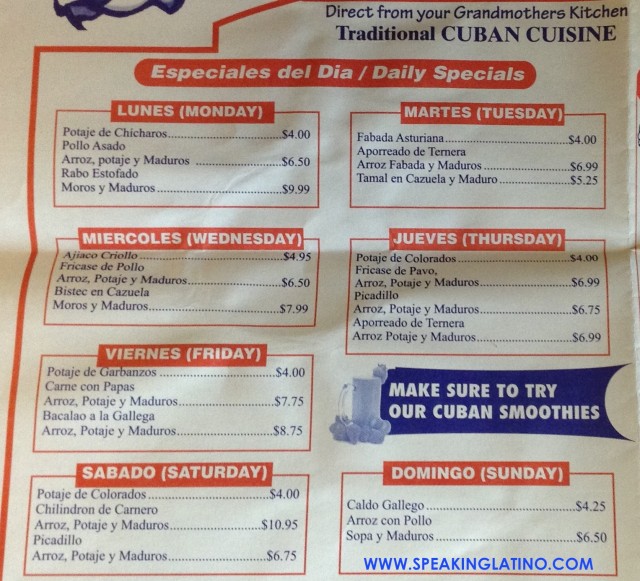Some time ago, Jared and I took a food tour in Little Havana, Miami. The experience was great because we were able to taste the wonderful Cuban food and learn about the history of Little Havana. Since I’m Puerto Rican I knew I was going to find many similar ingredients, such as the plantain, the rice and the seasoning. Awesome!
We continued our journey and stopped at a casual restaurant where a delicious Cuban sandwich awaited for us. While waiting, I stopped a moment to read the menu in Spanish and… surprise, surprise! Many of the names of the dishes were completely new to me!
But how is this possible if so much has been said about the historic ties that unite both islands? Remember the famous verse Cuba y Puerto Rico son de un pájaro las dos alas (Cuba and Puerto Rico are the two wings of a bird) and even our flags are almost identical! As it turns out my Caribbean heritage (or maybe my limited culinary skills) are not enough to decipher this particular Cuba Spanish slang.
This experience reminded me that when it comes to Spanish language diversity, the learning process never ends. I went back home and did a research of 14 Spanish food words.
14 Cuban Spanish Food Words And Dishes I Never Knew
So here is my list of words and dishes I had trouble understanding. Please note that many of these words could have a Spanish origin and may be shared with other countries.

1. ajiaco:
Broth-type stew with meat, fruits and tubers chopped into pieces and mixed with spices.
2. aporreado de ternera:
Ternera is veal, but lets focus on aporreado. Aporreado is a dish prepared with beef or cod, boiled and marinated, seasoned with tomato, garlic, onions and then fried in a little butter or oil.
3. bacalao a la gallega:
I know that bacalao is cod, but not what a la gallega style means. It turns out that a la gallega is a garlic and peppers “refrito” of garlic and peppers.
4. caldo gallego:
Galician white bean soup
5. chícharo:
I was clueless about this one and it turn out to be a pea. Spanish synonyms for chícharo are guisante, garbanzo or judía.
6. chilindrón:
Stew made with chunks of meat, poultry, pork or lamb, sauteed with tomatoes, peppers and other ingredients.
7. colorados:
This is an abbreviation for frijoles colorados or red beans.
8. fabada:
Bean stew with bacon, sausage and black pudding.
9. maduros:
Maduros is the short word for plátanos maduros or sweet plantains. I guessed this one correctly because we have those in Puerto Rico, but we commonly call them amarillos.
10. moros:
Here is another abbreviation. In this case moros is referring to the dish called Moros y Cristianos that is white rice cooked with black beans. The white and black color combination gave the name of this dish, which in English means Moors and Christians, a reference to the history of Spain.
11. picadillo:
This ambiguous description may leave you guessing. It is ground beef that I knew by the name of carne molida.
12 potaje:
The word potaje sounded familiar to me, but I was not sure of the meaning. It is a soup or caldo in Spanish.
13. rabo estofado:
I know what rabo and estofado are, but this is a dish its new for me. The description alone is not enough to understand that is braised oxtails or rabo de buey estofado.
14. tamal en cazuela:
If you’re expecting the traditional tamale, you’re wrong. The phrase a la cazuela means “in a pot.” The blog La Cocina de Nathan gave me the best explanation and pictures: “it is essentially polenta (a creamy corn porridge made from either course or fine cornmeal or freshly ground corn) stewed with generous fried pork pieces and sofrito (the base of Cuban cooking onion, garlic, bell pepper sometimes tomato) kissed with cumin and oregano.” So everything is cooked together in a pot and served like a creamy soup.
Those were only some words from the weekly specials. I just glanced at the rest of the menu and found fish names such as pargo and cherna. Lets leave those for another blog post.
Quick Guide to Cuban Spanish: Dictionary eBook
Check out these other Cuba Spanish Slang Word articles.